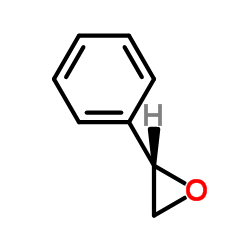(S)-Styrene oxide

(S)-Styrene oxide structure
|
Common Name | (S)-Styrene oxide | ||
|---|---|---|---|---|
| CAS Number | 20780-54-5 | Molecular Weight | 120.148 | |
| Density | 1.1±0.1 g/cm3 | Boiling Point | 193.9±9.0 °C at 760 mmHg | |
| Molecular Formula | C8H8O | Melting Point | N/A | |
| MSDS | Chinese USA | Flash Point | 79.4±0.0 °C | |
| Symbol |


GHS06, GHS08 |
Signal Word | Danger | |
|
Cloning and characterization of an epoxide hydrolase from Cupriavidus metallidurans-CH34.
Protein Expr. Purif. 79(1) , 49-59, (2011) A putative epoxide hydrolase-encoding gene was identified from the genome sequence of Cupriavidus metallidurans CH34. The gene was cloned and overexpressed in Escherichia coli with His(6)-tag at its N-terminus. The epoxide hydrolase (CMEH) was purified to nea... |
|
|
Simultaneous determination of aromatic acid metabolites of styrene and styrene-oxide in rat urine by gas chromatography-flame ionization detection.
J. Anal. Toxicol. 36(5) , 312-8, (2012) A convenient and reliable gas chromatographic method was developed for the simultaneous determination of six aromatic acid metabolites of styrene and styrene-oxide in rat urine; i.e., benzoic (BA), phenylacetic (PAA), mandelic (MA), phenylglyoxylic (PGA), hip... |
|
|
Solvent and TMEDA effects on the configurational stability of chiral lithiated aryloxiranes.
Chemistry 17(29) , 8216-25, (2011) The employment of hexane/N,N,N',N'-tetramethylethylenediamine (TMEDA) dramatically hinders the racemization of those lithiated styrene oxides (trifluoromethyl-, chloro-, and phenylthio-substituted) that have been proven to be configurationally unstable in THF... |
|
|
Comparison of styrene oxide enantiomers for hepatotoxic and pneumotoxic effects in microsomal epoxide hydrolase-deficient mice.
J. Toxicol. Environ. Health A 74(6) , 347-50, (2011) Styrene is hepatotoxic and pneumotoxic in mice. Styrene oxide, the active metabolite, is detoxified via hydrolysis by microsomal epoxide hydrolase (mEH). Racemic styrene oxide was previously found to be more lethal and produced increased toxicity in mEH-/- mi... |
|
|
Insensitivity of the in vitro cytokinesis-block micronucleus assay with human lymphocytes for the detection of DNA damage present at the start of the cell culture.
Mutagenesis 27(6) , 743-7, (2012) The cytokinesis-block micronucleus assay (CBMN assay) with cultured human lymphocytes is a well-established assay in genotoxicity testing and human biomonitoring. For both approaches, human lymphocytes are stimulated by phytohaemagglutinin (PHA) and cultured ... |
|
|
Modification of the metabolism and toxicity of styrene and styrene oxide in hepatic cytochrome P450 reductase deficient mice and CYP2F2 deficient mice.
Toxicology 294(2-3) , 104-8, (2012) Styrene causes toxicity in both the lung and the liver. The study of the relationship of this toxicity to the metabolism of styrene has been aided by the use of knockout mice for both bioactivation and detoxification pathways. It has been hypothesized that CY... |
|
|
Styrene oxide isomerase of Rhodococcus opacus 1CP, a highly stable and considerably active enzyme.
Appl. Environ. Microbiol. 78(12) , 4330-7, (2012) Styrene oxide isomerase (SOI) is involved in peripheral styrene catabolism of bacteria and converts styrene oxide to phenylacetaldehyde. Here, we report on the identification, enrichment, and biochemical characterization of a novel representative from the act... |
|
|
Characterization of the epoxide hydrolase NcsF2 from the neocarzinostatin biosynthetic gene cluster.
Org. Lett. 12(17) , 3816-9, (2010) Neocarzinostatin (1) biosynthesis is proposed to involve a vicinal diol intermediate. It is reported that NcsF2, one of two epoxide hydrolases encoded by the NCS gene cluster, catalyzes regiospecific addition of H(2)O to C-2 of both (R)- and (S)-styrene oxide... |
|
|
Laboratory evolution of an epoxide hydrolase - towards an enantioconvergent biocatalyst.
J. Biotechnol. 156(1) , 1-10, (2011) We performed a laboratory evolution study with the epoxide hydrolase from Aspergillus niger M200. This enzyme exhibits no enantioconvergence with the substrates styrene oxide or para-chlorostyrene oxide, i.e. racemic vicinal diols are produced from the racemi... |
|
|
Metabolism and toxicity of styrene in microsomal epoxide hydrolase-deficient mice.
J. Toxicol. Environ. Health A 73(24) , 1689-99, (2010) Styrene, which is widely used in manufacturing, is both acutely and chronically toxic to mice. Styrene is metabolized by cytochromes P-450 to the toxic metabolite styrene oxide, which is detoxified via hydrolysis with microsomal epoxide hydrolase (mEH) playin... |